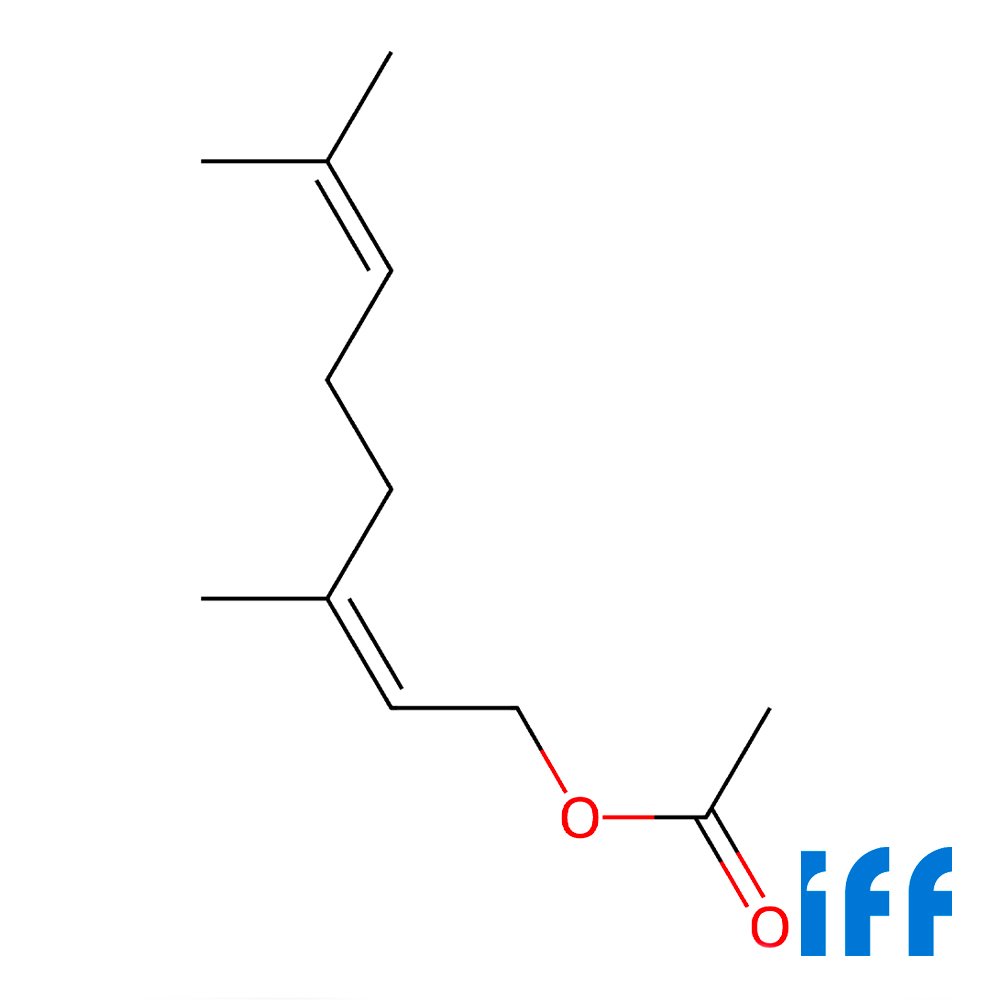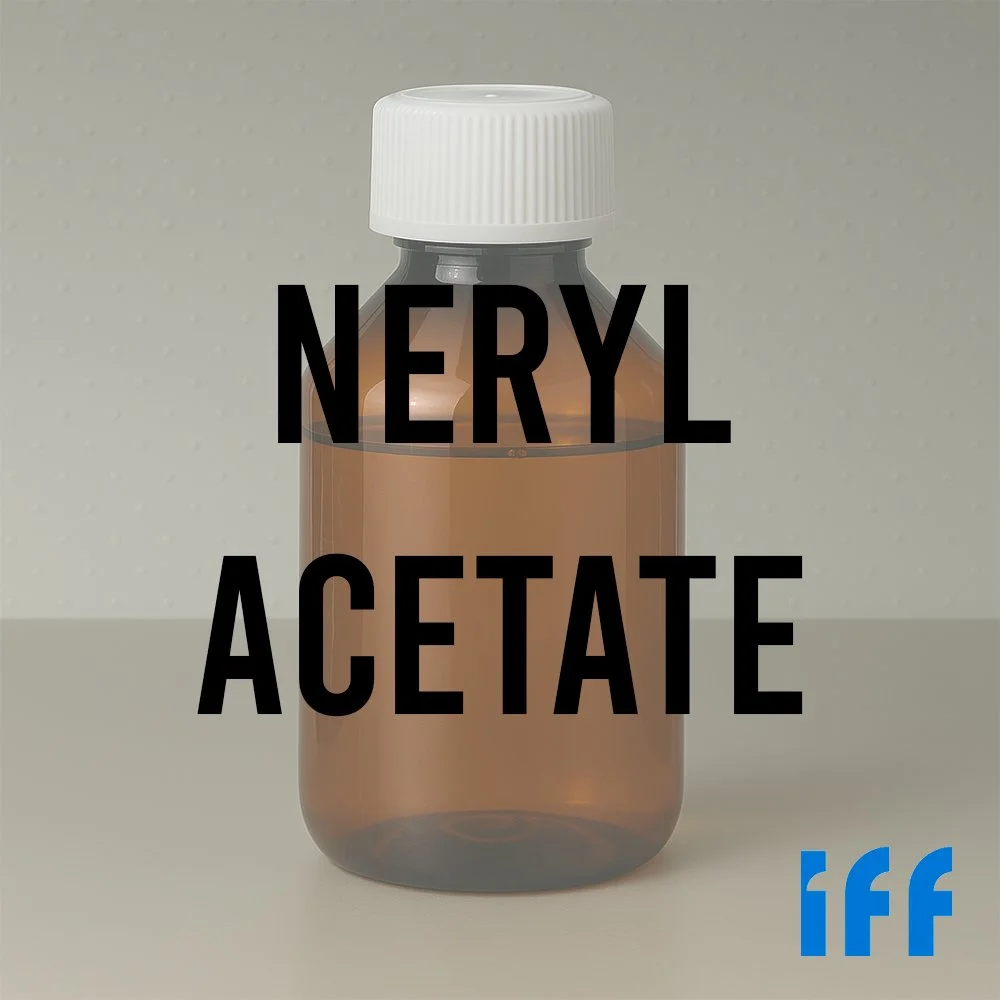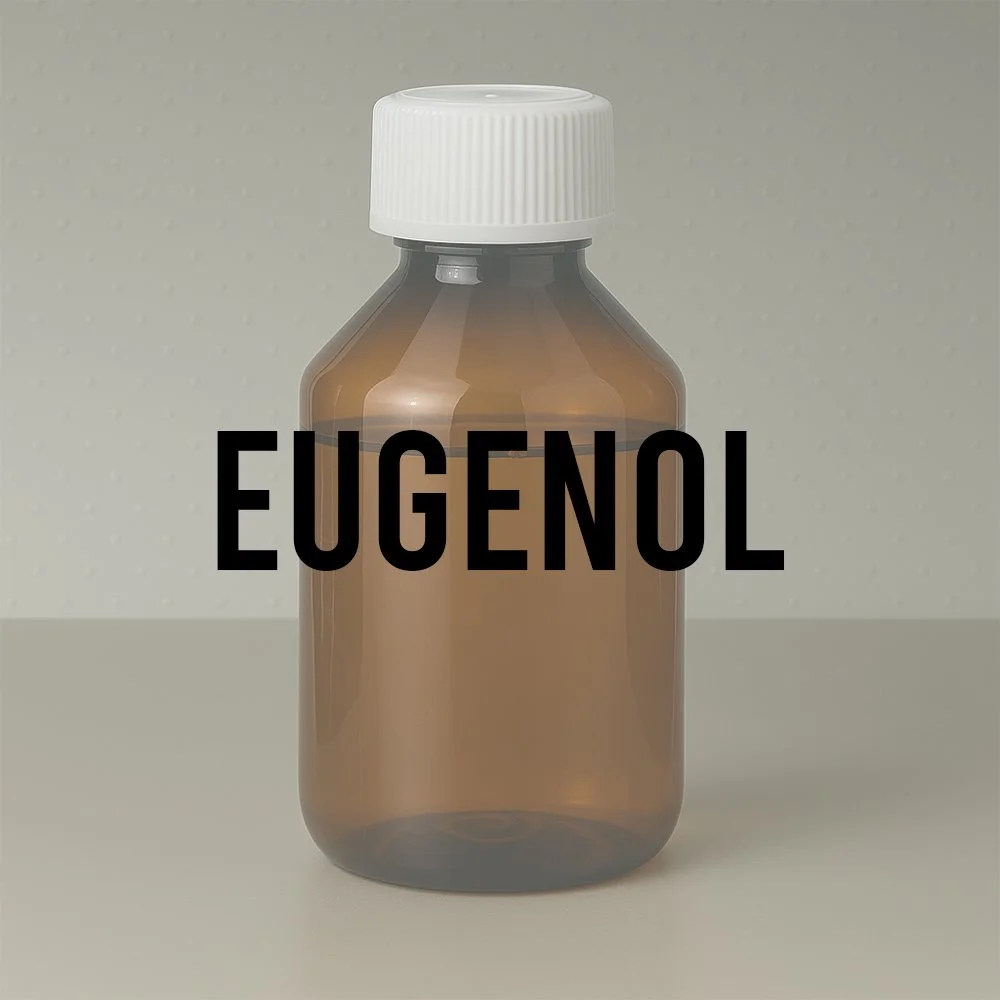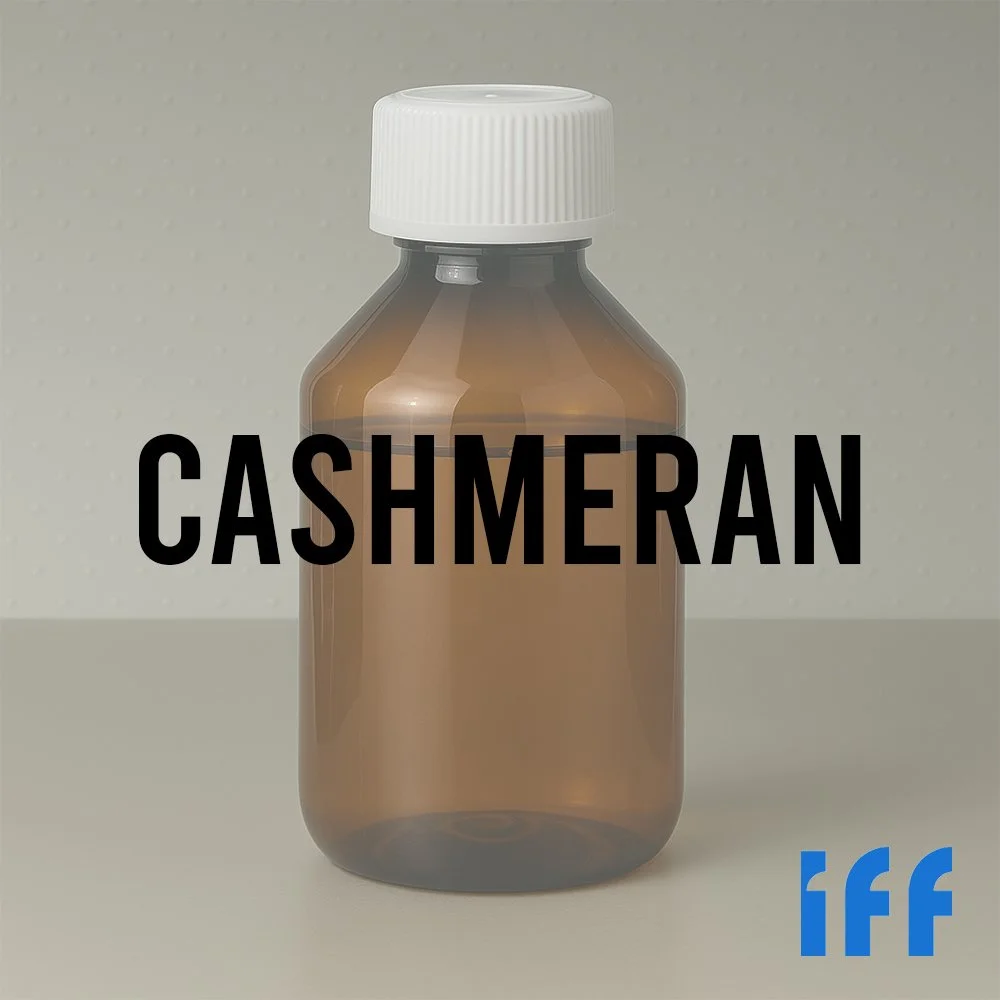Neryl Acetate Technical Ingredient Overview
🏭 Manufacturer — IFF
🔎 Chemical Name — (Z)-3,7-Dimethylocta-2,6-dienyl acetate
🧪 Synonyms — Nerol acetate; cis-Geranyl acetate; cis-3,7-Dimethyl-2,6-octadien-1-yl acetate; 2,6-Octadien-1-ol, 3,7-dimethyl-, acetate, (2Z)-; Neryl ethanoate
📂 CAS Number — 141-12-8
📘 FEMA Number — 2773
⚖️ Molecular Weight — 196.29 g/mol
📝 Odor Type — Floral-fruity, citrus blossom
📈 Odor Strength — Medium to strong; more powerful than its geometric isomer geranyl acetate
👃🏼 Odor Profile — Very sweet, soft floral aroma reminiscent of orange blossom, neroli, and rose with fresh, dewy characteristics. Secondary notes of raspberry, pear, and honey-like sweetness. Lacks sharp aldehydic edges. Initially fresh and pungent on the palate, transitioning to honey-like with raspberry undertones
⚗️ Uses — Fine fragrance (neroli, jasmine, rose, magnolia compositions), functional fragrance (body care, household products), food flavoring (citrus, floral, fruity profiles), aromatherapy
🧴 Appearance — Colorless to pale yellow clear liquid
What is Neryl Acetate?
Neryl Acetate is a monoterpene ester characterized by a (Z)-configured double bond at the C-2 position of its isoprenoid chain. It is the acetate ester of nerol and represents the geometric (cis) isomer of the more common geranyl acetate. This stereochemical difference—the Z-configuration versus the E-configuration of geranyl acetate—confers distinct olfactory properties, with Neryl Acetate exhibiting a softer, sweeter, more powerful floral character compared to its geometric counterpart (Arctander, 1969).
While Neryl Acetate occurs naturally in several essential oils including neroli, petitgrain bigarade, helichrysum, bergamot, and lavender, the majority of commercial-grade material is produced semi-synthetically to ensure high purity, olfactory consistency, and cost-effectiveness. The compound belongs to the broader family of acyclic monoterpene esters that serve critical roles in natural fragrance and flavor profiles.
The molecule's moderate volatility, low irritancy potential, and non-reactivity in formulations make it suitable across diverse applications, from fine fragrance to functional perfumery and food flavoring. Its specific stereochemistry results in superior diffusion and substantivity compared to the trans isomer, making it particularly valuable in high-quality neroli and orange blossom reconstructions (Rowe, 2005).
Historical Background
Neryl Acetate derives its name from neroli oil (orange blossom oil), one of the key natural sources from which it was first identified. The compound has been recognized in perfumery since the early 20th century, when advances in analytical chemistry allowed perfumers to identify and isolate individual components from complex essential oils.
The semi-synthetic production of Neryl Acetate became commercially viable in the mid-20th century through esterification of nerol with acetic acid or acetic anhydride. An alternative synthetic route developed later involves the two-stage conversion of myrcene: first through hydrobromination catalyzed by copper(I) chloride, followed by acetolysis using sodium acetate and a base such as triethylamine. This latter method produces both Neryl Acetate and Geranyl Acetate as geometric isomers, which can then be separated (Rowe, 2005).
Commercial grades typically contain approximately 55-65% Neryl Acetate with 35-45% Geranyl Acetate, as complete separation is often economically unnecessary for most applications. However, higher-purity grades (>90% Neryl Acetate) command premium pricing in fine fragrance applications where the specific olfactory character is critical.
Olfactory Profile
Scent Family
Classification: Floral-fruity with citrus blossom nuances
Primary Category: Top-to-heart note monoterpene ester
Natural Occurrence: Neroli, petitgrain bigarade, helichrysum, lavender, bergamot
Main Descriptors
Neryl Acetate presents a characteristically sweet, soft floral profile dominated by orange blossom and neroli notes. The aroma is notably softer and rounder than Geranyl Acetate, with enhanced sweetness and fruity depth. Primary floral impressions include fresh rose, jasmine, and magnolia, while secondary fruity facets evoke dewy pear, raspberry, and tropical fruit nuances.
The material exhibits a fresh, clean quality without the sharp or aggressive characteristics sometimes associated with aldehyde-based floral materials. In flavor applications at 10 ppm, it delivers floral, rosy, soapy, fruity, pear, and tropical taste characteristics with an initial fresh pungency that evolves into honey-like sweetness with raspberry undertones (FEMA, 2773).
According to Arctander (1969), Neryl Acetate "costs several times more than Geranyl acetate, but has much more sweet and fruity power," making it particularly valuable when specific olfactory impact is required despite higher material costs.
Intensity
Strength Rating: Medium to strong
Comparative Power: More powerful and diffusive than Geranyl Acetate
Detection Threshold: 2-8.5 ppm
The material exhibits exceptional diffusion relative to its concentration, providing strong top-note impact while maintaining presence through the heart phase of a fragrance.
Tenacity
Longevity: Moderate (typical for top-to-heart note esters)
Persistence: Good substantivity on skin and textiles; effective through wash cycles in functional applications
Volatility
Evaporation Rate: Moderate (characteristic of acyclic monoterpene esters)
Boiling Point: 134°C at 3.4 kPa (134°C at 25 mmHg)
Classification: Top-to-heart note
Neryl Acetate functions as a connector between the volatile top notes and the more substantive heart notes, providing continuity and radiance throughout the fragrance development.
Applications in Fine Fragrance
Neryl Acetate is extensively employed in blossom compositions, particularly neroli, jasmine, rose, and magnolia accords. Its soft, sweet floral character makes it indispensable for creating naturalistic orange blossom and neroli reconstructions, where it provides both olfactory authenticity and radiance. The material is particularly effective when specific floral impact is desired without excessive cost, serving as a potent alternative to more expensive natural extracts.
In modern perfumery, Neryl Acetate is valued for its ability to add body and roundness to floral and fruity compositions. It pairs exceptionally well with other citrus notes (bergamot, lemon, petitgrain), white florals (jasmine, tuberose, gardenia), and rose materials. The material also enhances fruity-floral accords and provides natural lift to magnolia and peony compositions (Takasago, 2025).
Performance in Formula
Stability: Neryl Acetate demonstrates good stability in most formulation matrices. As an ester, it can undergo hydrolysis under extremely acidic or alkaline conditions, but remains stable under typical cosmetic and fragrance pH ranges (4-8). The material is moderately stable toward alkali, allowing its use in soap formulations, though with some limitations in highly alkaline systems.
Solubility: Soluble in alcohol, oils, and most organic solvents; practically insoluble in water (density: 0.91 g/mL at 25°C; refractive index: n₂₀/D 1.460).
Typical Use Level: 0.05-10 ppm in food applications (FEMA 2773); up to several percent in fine fragrance; adjustable based on desired impact in functional fragrance applications.
Industrial & Technical Uses
Beyond perfumery, Neryl Acetate serves as a FEMA GRAS-listed flavor ingredient (FEMA 2773) for use in food and beverage applications where citrus-floral-fruity notes are desired. Its applications include citrus beverages, fruit confections, baked goods, and dairy products. The material is also utilized in aromatherapy products for its calming, stress-relief properties.
Research has explored Neryl Acetate's potential as a natural insect repellent (biopesticide applications) and its mild antimicrobial and anti-inflammatory properties, though these applications remain primarily investigational rather than commercial at present.
Regulatory & Safety Overview
IFRA Status
Current Status: Not restricted in IFRA Amendment 51 (notified June 30, 2023)
Classification: General guidance applies; no specific maximum acceptable concentrations established
Neryl Acetate does not appear among the 48 new standards or revised standards introduced in the 51st Amendment to the IFRA Standards. The material may be used in accordance with good manufacturing practices for fragrance ingredients.
For current IFRA Standards, consult: https://ifrafragrance.org/standards-library
EU Cosmetics Regulation
Compliance: Compliant with EU Cosmetics Regulation (EC) No 1223/2009
Allergen Status: Not listed among the 26 mandatory declarable fragrance allergens under EU Regulation 1223/2009 Annex III
FEMA Status
FEMA Number: 2773
Flavis Number: 9.213
Classification: GRAS (Generally Recognized As Safe) for use as a flavor ingredient under conditions of intended use as evaluated by the FEMA Expert Panel
The material meets purity specifications established by JECFA (Joint FAO/WHO Expert Committee on Food Additives) and follows IFRA guidelines for fragrance applications.
Toxicology
Neryl Acetate exhibits low toxicity by ingestion and dermal contact. The material is classified with relatively minimal hazard under standard chemical safety classifications. Standard precautionary measures for handling fragrance materials should be observed. When heated to decomposition, it may emit acrid smoke and irritating vapors. The compound should be stored in cool, dry conditions away from heat sources and incompatible materials.
References
Arctander, S. (1969). Perfume and flavor chemicals (aroma chemicals). Montclair, NJ: Allured Publishing Corporation.
ChemicalBook. (2025). Neryl acetate (141-12-8). Retrieved from https://www.chemicalbook.com/ChemicalProductProperty_EN_CB8269252.htm
FEMA. (2025). Flavor ingredient library: FEMA 2773 - Neryl acetate. Flavor and Extract Manufacturers Association. Retrieved from https://www.femaflavor.org/flavor-library
IFRA. (2023). Notification of the 51st Amendment to the IFRA Standards. International Fragrance Association. Retrieved from https://ifrafragrance.org/standards-library
Rowe, D. J. (Ed.). (2005). Chemistry and technology of flavors and fragrances. Oxford: Blackwell Publishing.
Sigma-Aldrich. (2025). Neryl acetate analytical standard. Product specification W277304. Retrieved from https://www.sigmaaldrich.com
Takasago International Corporation. (2025). Neryl acetate technical data. Retrieved from https://www.takasago.com/en/node/697











